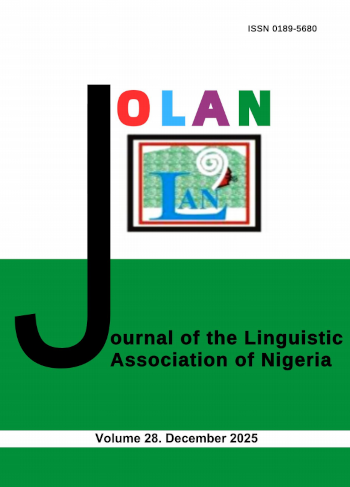Naming and Name-Giving in Kambari Culture
Keywords:
Kambari, Cultural name, Age group, Status, Social DistanceAbstract
This paper demonstrates how Kambari speakers often use names as linguistic resources to identify individuals in a variety of social functions in everyday informal interactions. Kambari is among the Niger-Congo family of languages, which is situated in the Northern part of Nigeria. The cluster is situated predominantly in some local governments of Niger State and Kebbi State (Magama, Agwara, Rijau, New-Bussa, Mashegu and Bangi –Niger State and Warra, Yauri and Shanga – Kebbi State). The intention of this paper is two-fold: to contribute to research in Kambari cultural names, often limited as a mere verbal play, by illustrating their communicative utility and to present the common functions cultural names fulfil in particular relationships and situations. The data reveal that Kambari cultural name occurs in a wide array of relationships and age group, although it happens in both male and female. The forms cultural names take and the naming patterns depend on the social distance between the participants, their relative social statuses, the context of name-giving and the speakers’ intention. The data for this paper came from natural environment where the Kambari speakers are dominant (in Salka and Raba town) in Magama Local Government Area of Niger State, from the researcher’s observations taken from naturally occurring interactions in public and private spheres with the native Kambari speakers of varying ages, gender, social status, occupation and religious affiliations.
References
Antoun, R. 1968, “On the significance of names in an Arab village,” Ethnology, 7:158-170.
Barrett, R. 1978, “Village modernization and changing nicknaming practices in Northern Spain,”
Journal of Anthropological Research, 34: 92-108.
Blum-Kulka, S. and T. Katirel 1991, “Nicknaming practices in Families: A cross-cultural perspective,” in Ting-Toomey Stella and Felipe Korzenny (eds.) Cross-Cultural interpersonal communication, pp. 58-78 Newbury/London: Sage Publications.
Boxer, D. 1993, “Social distance and speech behaviour: The case of indirect Complains,” Journal of Pragmatics, 19: 103-125.
Crozier, W. R. 2002, Donkeys and Dragons: Recollections of schoolteachers' nicknames. Educational Studies, 28(2), 133-142.
Crozier, W. R., & Dimmock, P. S. 1999, Name-calling and nicknames in a sample of primary school children. British Journal of Educational Psychology, 69(4), 505-516.
De Klerk, V. and B. Bosch 1997, “Naming practices in the Eastern Cape Province of South Africa,” Names, 44 (3): 167-188.
Finnegan R 1970. Oral Literature in Africa. New York: Oxford University Press.
Gilmore, D. D. 1982, “Some notes on community nicknaming in Spain,” Man, 17:686-700.
Glazier, J. 1987, “Nicknaming and the transformation of an American Jewish Community: Notes on the anthropology of emotion in the urban Midwest, Ethnology, 26 (2): 73-85.
Guma, M. 2001. The cultural meaning of names among Basotho of Southern Africa: A historical and linguistic analysis. Nordic Journal of African Studies 10 (3): 265 – 279.
Liao, C. C. 2006, Linguistic analysis of nicknames of junior high school students. Journal of Language and Linguistics, 5(1), 68-86.
McDowell, J. 1981, “Towards a semiotics of nicknaming: The Kamsa example,” Journal of American Folklore, 94: 1-18.
Mbiti JS 1975. Introduction to African Religion. Cambridge: Cambridge University Press.
Morgan, J., C., O’Neill and R. Harre 1979, Nicknames: Their Origins and Social Consequences, London: Routledge and Kegan Paul.
Nze, B.C. 1989. Sense and non-sense in Igbo names. Nsukka Journal of the Humanities 5 (6)
Philipsen, G. and M. Huspek 1985, “A bibliography of sociolinguistic studies of Personal address,” Anthropological Linguistics, 27 (1): 94-101.
Seeman, M. V. 1980. Names and identities. Can. J. Psychiatry. 25: 129 – 127.
Ubahakwe, E. 1982. Culture content of Igbo names. Igbo language and culture. Ibadan: University
Press.
Wardat, M. 1997, Nicknaming in Jordanian Arabic: A sociolinguistic perspective. Interface, 12(1), 45-58.
Wierzdicka, A. 1992, Semantic, Culture and Cognition, Oxford: Oxford University Press.
Wolfson, N. 1988, “The bulge: A theory of speech behaviour and social distance,” in J. Fine (ed.) Second Language Discourse: A Textbook of Current Research, pp.21-38, Norwood, NJ: Ablex.














